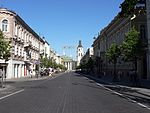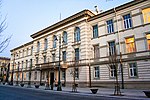
Vilnius, previously known in English as Vilna, is the capital of and largest city in Lithuania and the second-most-populous city in the Baltic states. The city's estimated July 2024 population was 605,270, and the Vilnius urban area has an estimated population of 708,627.
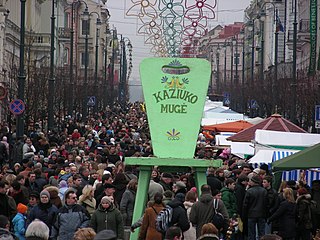
Kaziuko mugė or Saint Casimir's Fair is a large annual folk arts and crafts fair in Lithuania, dating to the beginning of the 17th century. The fair is traditionally held in city's markets and streets on the Sunday nearest to 4 March, the anniversary of Saint Casimir's death. In Lithuanian, Kaziukas is a diminutive of Casimir. Today, Saint Casimir's fair also features music, dance, theater performances; it attracts tens of thousands of visitors and many craftsmen from across Lithuania as well as from neighbouring countries such as Latvia, Russia, and Poland. In recent years, the fair has expanded into other cities in Lithuania, Belarus, Poland.
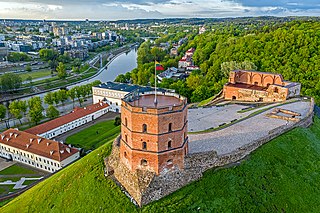
Gediminas' Tower is the remaining part of the Upper Castle on top of the Gediminas Hill in Vilnius, Lithuania. It has a viewing platform that offers scenic views of Vilnius Old Town and Vilnius Central Business District.
The city of Vilnius, the capital and largest city of Lithuania, has an extensive history starting from the Stone Age. The city has changed hands many times between Imperial and Soviet Russia, Napoleonic France, Imperial and Nazi Germany, Interwar Poland, and Lithuania.

The Old Town of Vilnius, one of the largest surviving medieval old towns in Northern Europe, has an area of 3.59 square kilometres. It encompasses 74 quarters, with 70 streets and lanes numbering 1487 buildings with a total floor area of 1,497,000 square meters. It was founded by the Lithuanian Grand Duke and King of Poland Jogaila in 1387 on the Magdeburg rights the oldest part of the Lithuanian capital of Vilnius, it had been developed over the course of many centuries, and has been shaped by the city's history and a constantly changing cultural influence. It is a place where some of Europe's greatest architectural styles—gothic, renaissance, baroque and neoclassical—stand side by side and complement each other. There are many Catholic, Lutheran and Orthodox churches, residential houses, cultural and architectural monuments, museums in the Old Town.

The Cathedral Basilica of St Stanislaus and St Ladislaus of Vilnius is the main Catholic cathedral in Lithuania. It is situated in Vilnius Old Town, just off Cathedral Square. Dedicated to the Christian saints Stanislaus and Ladislaus, the church is the heart of Catholic spiritual life in Lithuania.

The Cathedral Square in Vilnius is the main square of the Vilnius Old Town, right in front of the neo-classical Vilnius Cathedral. It is a key location in city's public life, situated as it is at the crossing of the city's main streets and reflecting the city's diversity. Regularly held at this site are fairs and gatherings of townspeople, military parades, religious and official public events, attractions and large concerts, New Year’s salutes and exhibitions. It is not merely the most lively and important location in the city, but is also one of the most significant and widely known symbols of Lithuania.

The Vilnius Castle Complex is a group of cultural, and historic structures on the left bank of the Neris River, near its confluence with the Vilnia River, in Vilnius, Lithuania. The buildings, which evolved between the 10th and 18th centuries, were one of Lithuania's major defensive structures.

The Cathedral of the Theotokos in Vilnius is the episcopal see of the Russian Orthodox Diocese of Lithuania.
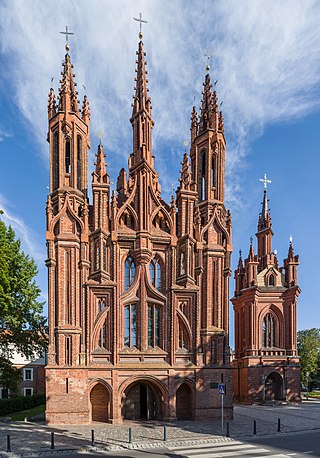
St. Anne's Church is a Roman Catholic church in Vilnius' Old Town, on the right bank of the Vilnia river established circa 1495–1500. It is a prominent example of both Flamboyant and Brick Gothic styles. St. Anne's is a prominent landmark in the Vilnius Old Town that enabled the district to be named as a UNESCO World Heritage Site, and is one of the most interesting examples of Gothic architecture in Lithuania.

The national symbols of Lithuania are used in Lithuania and abroad to represent the country and its people, history, culture, and nature. These symbols are seen in official capacities, such as flags, coats of arms, postage stamps, and currency, and in URLs. They appear less formally as recurring themes in literature, art and folk art, heraldry, monuments, clothing, personal decoration, and as the names of parks, bridges, streets, and clubs. The less formal manifestations may be classified as national emblems.

Tuskulėnai Manor is a neoclassical manor in Žirmūnai elderate of Vilnius, Lithuania. It is best known as burial grounds of people executed by the KGB in 1944–1947. After Lithuania regained independence in 1990, the manor was reconstructed and the park was transformed into a memorial to the victims of Soviet repressions. It is administered by the Lithuanian Genocide and Resistance Research Center.

Lukiškės Square is the largest square (about 4 hectares in Vilnius, Lithuania, located in the center of the city. A major street in Vilnius, Gediminas Avenue, passes by the southern border of the square. It is surrounded by many public buildings, including the Ministry of Finance, Ministry of Foreign Affairs, Court of Appeal, Academy of Music and Theatre, Church of Saints Philip and James, and the Dominican monastery with the former St. Jacob Hospital.
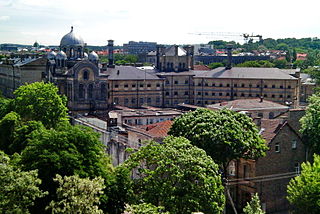
Lukiškės Prison was a prison in the center of Vilnius, Lithuania, near the Lukiškės Square.

Jakub Wygodzki was a Polish–Lithuanian Jewish politician, Zionist activist and a medical doctor. He was one of the most prominent Jewish activists in Vilnius. Educated as a doctor in Russia and Western Europe, he established his gynecology and pediatric practice in 1884. In 1905, he was one of the founding members of the Constitutional Democratic Party (Kadets) in Vilnius Region. In 1918, he was co-opted to the Council of Lithuania and briefly served as the first Lithuanian Minister for Jewish Affairs. After Vilnius was captured by Poland, Wygodzki was elected to the Polish parliament (Sejm) in 1922 and 1928. He died in the Lukiškės Prison during the first months of the German occupation of Lithuania during World War II.
The following is a timeline of the history of the city of Vilnius, Lithuania.

Tiškevičiai Palace is a former residential palace in Vilnius Old Town, near the intersection of Trakų and Pylimo streets.

The 1st Infantry Regiment, later the 1st Infantry Regiment of the Lithuanian Grand Duke Gediminas was an infantry regiment that served in the Lithuanian Army during the Interwar period.

Gediminas' Cap was the most important regalia of the Lithuanian monarchs who ruled the Grand Duchy of Lithuania until the Union of Lublin in 1569. During the inaugurations of Lithuanian monarchs, Gediminas' Cap was placed on the monarch's heads by the Bishop of Vilnius in Vilnius Cathedral.



